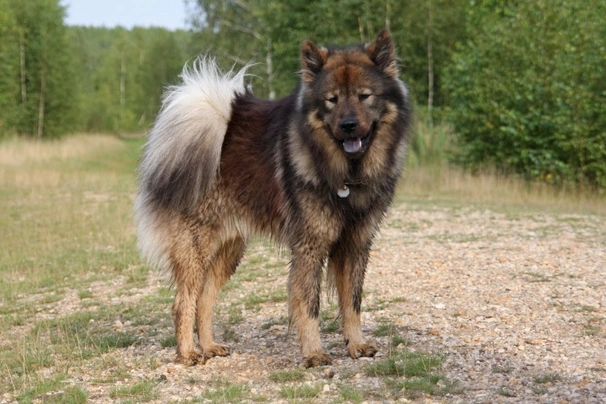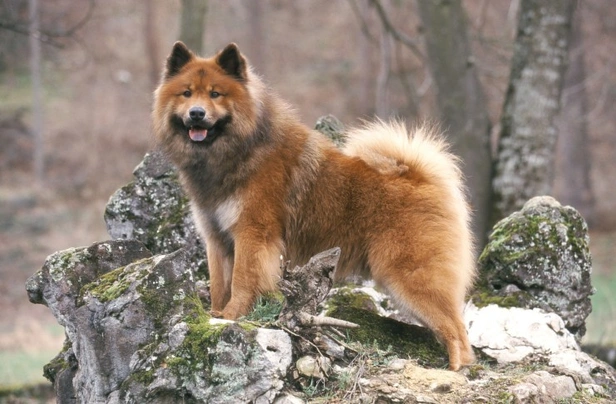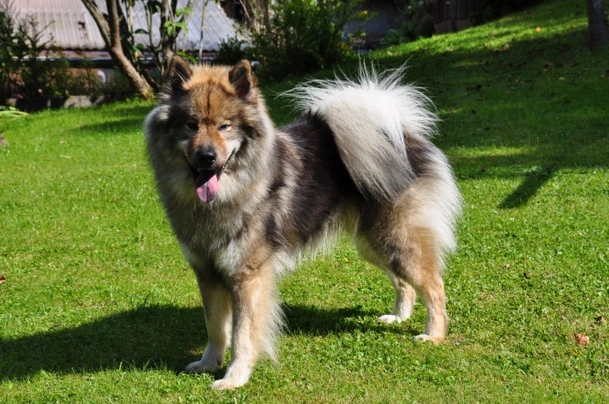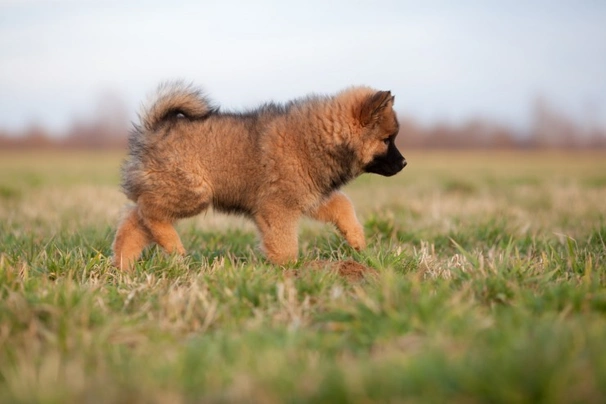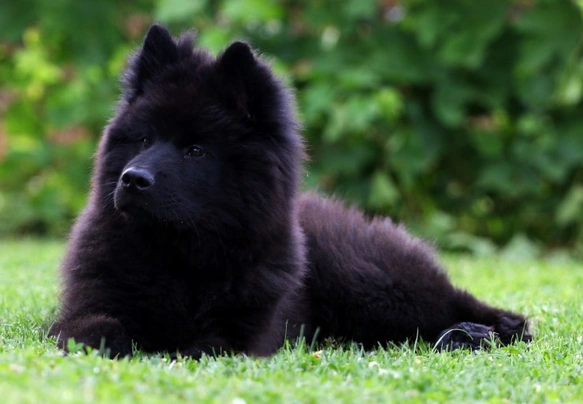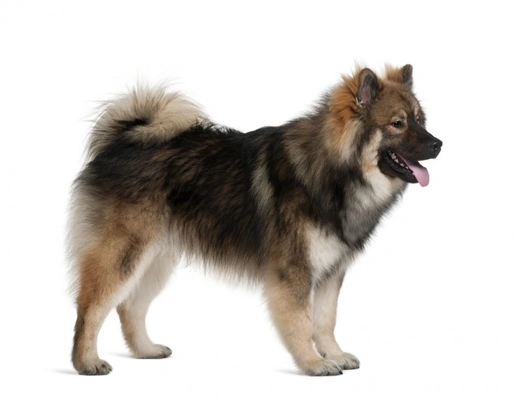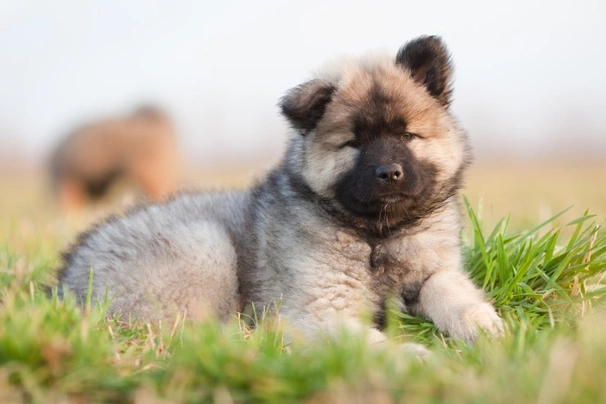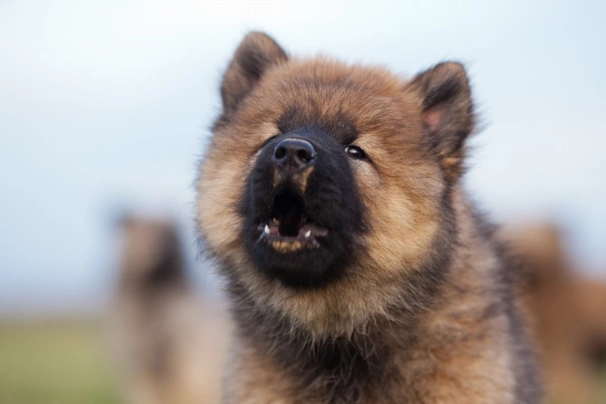Eurasier
Pros
Cons
Introduction of the Eurasier
The Eurasier is a medium sized Spitz type dog that's often referred to as a Eurasian. The breed originates from Germany where they were first bred in the 1960's by Julius Wipfel who wanted to combine the characteristics of the Chow Chow with the Wolf Spitz. Over the years these attractive dogs have earned themselves the reputation for being calm and even tempered. They are also known to form strong bonds with their families which is why they have remained a popular choice both as a companion dog and family pet in their native Germany. With this said the Eurasier is still relatively unknown here in the UK although the breed is now gaining a little recognition albeit slowly.
History of the Eurasier
The Eurasier is a relatively new breed having only been developed in Germany during the 1950's by the Wipfel family. A breeder by the name of Julius Whipfel bred the first of these dogs wanting to combine the characteristics of the Chow Chow with the German Wolf Spitz. The first dogs were known as "Wolf-Chows". A few years later the Samoyed was introduced into the mix to produce the dogs we see today.
Although Julius Whipfel is credited for being the founding breeder there are those who believe the Eurasier to be a regeneration of the Laika an ancient Russian breed and a dog that lived with tribes in Central Siberia. However it is known that his dogs inherited their traits from their parent breeds and as such they have wedge-shaped heads with striking almond-shaped eyes paired to a gentle and affectionate nature.
With this said the breeds used to create the Eurasier were German Wolfspitzes and Chow Chows although they did not look like the Chows we see today. At first they were known as "Wolf-Chows". However later Wipfel introduced Samoyed into the mix and a little later the breed was recognised by the German Kennel Club (VDH). In 1973 the breed was recognised by the FCI when the breed's name was changed to the Eurasier. A short time later the Kennel Club recognised the Eurasier and today these charming dogs are gaining popularity outside of their native Germany thanks to their attractive looks and kind gentle and loyal natures.
Interesting facts about the breed
- Is the Eurasier a vulnerable breed? No but anyone wanting to share a home with one would need to register their interest with breeders and go on a waiting list for the pleasure of doing so
- Unlike many other spitz-type breeds the Eurasier is not known to have a high prey drive
- The breed is relatively new to the scene only having been developed in Germany during the 1950’s
- They are renowned for being wonderful companions and family pets
- Very few well-bred Kennel Club registered puppies are available every year and as such they can command a lot of money
Appearance of the Eurasier
Height at the withers: Males 52 - 60 cm Females 48 - 56 cm
Average weight: Males 23 - 32 kg Females 18 - 26 kg
The charming Eurasier has inherited many of their parent breed traits both physical and temperament-wise. They boast having the striking almond-shaped eyes and the wedge-shaped head of the Spitz paired to a charming gentle and affectionate nature of both parent breeds. Their heads are quite wide with dogs having a distinct furrow at the front of their faces and together with a nicely defined occiput (back of their heads) it adds to their quite charming looks. They only have a very slight stop and their muzzles taper gently with dogs having a medium sized black nose.
Their eyes are oval shaped dark in colour and slanting with black pigmented rims. Ears are triangular and medium in size with the tips being slightly rounded. Dogs carry their ears pricked and they are set nicely apart on their heads. The Eurasier has a strong jaw with a perfect scissor bite where their upper teeth neatly overlap their lower ones. Their necks are set well and muscular being moderately long. Forequarters are muscular with a moderate amount of bone with dogs having strong straight front legs and slightly sloping shoulders.
The Eurasier has a compact well-muscled body with firm well-defined withers straight backs and a nice width to their loin. Their croup is level strong and broad with dogs boasting an oval shaped ribcage that reaches down to their elbows. Their forechests are well developed and bellies slightly tucked up which adds to a dog's athletic appearance. Their back legs are straight strong with dogs having well-muscled upper and lower thighs.
Feet are oval shaped with tight nicely arched toes and well cushioned firm black paw pads that have thick hair in between them. Their nails are strong and dark in colour. Tails are set high being firm and round with a good amount of thickness but this tapers to the tip. Dogs carry their tails forward whether it's curved or curled over their backs. Some dogs carry their tail forward and to one side. When relaxed an Eurasier lets their tail hang down but they always carry it up and curled when excited or alert.
When it comes to their coat the Eurasier boasts having a double coat that consists of a harsh topcoat that's moderate in length and which lies loosely to a dog's body and a much thicker softer undercoat. The hair on a dog's muzzle face ears and on the front of their legs is shorter. However the hair on their tails and on the backs of their legs are nicely feathered with much longer hair. It's also longer around a dog's neck which forms their distinctive mane. Accepted breed colours for Kennel Club registration are as follows:
- Black
- Black & Tan
- Cream Black Mask
- Fawn
- Fawn & Black
- Grey
- Red
- Red & Black
- Red Black Mask
- Red Fawn
- Red Sable
- Sable
Gait/movement
When an Eurasier moves they take moderate strides covering a lot of ground when they do.
Faults
The Kennel Club frowns on any exaggerations or departures from the breed standard and would judge the faults on how much they affect a dog's overall health and wellbeing as well as their ability to perform.
Males should have both testicles fully descended into their scrotums and it is worth noting that a dog can be a little lighter or heavier as well as slightly taller or shorter than set out in the Kennel Club breed standard which is only given as a guideline.
Temperament of the Eurasier
The Eurasier thrives on human contact and become totally devoted to their families. They seem to have a real affinity with children and love to be involved in everything that goes on in a household. They are incredibly loyal to the people they love which is just one of the reasons they make such great family pets. However because they are so smart it's essential for their training to start as early as possible and for it to be consistent throughout their lives. This helps a dog understand what is expected of them.
Early socialisation is also very important and the sooner an Eurasier is introduced to as many new situations noises people animals and other pets the better. It will help them adjust and accept everything they encounter later in their lives without feeling stressed out in any way. With this said Eurasiers tend to be naturally wary of anyone they first meet although they would never show any sort of aggressive behaviour towards a stranger preferring to just keep their distance and let their owners know they are not happy about something.
They are sensitive dogs by nature and as such they do not answer well to any sort of harsh correction or heavy-handed training methods. They do respond well to positive reinforcement which brings out the best in an Eurasier. They are very good choice of family dogs in households where at least one person remains at home when everyone else is out of the house because they thrive on human contact and don't do well when they are left on their own for any length of time.
If left to their own devices and not given enough exercise and mental stimulation on a daily basis an Eurasier is very likely to develop separation anxiety which can lead to all sorts of behavioural. This includes dogs becoming depressed and withdrawn or at the other end of the scale they may well start being destructive around the home and barking incessantly causing problems with neighbours.
Are they a good choice for first time owners?
Eurasier are a good choice for first time dog owners because they are so amenable and people-oriented loving nothing more than to please and to entertain their families. They are particularly good with young children and older people too although playtime can get a bit boisterous at times.
What about prey drive?
It is said that Eurasiers do not generally have a high prey drive but this is not strictly the case because some of them cannot resist taking off after a rabbit or squirrel they spot in the distance whereas others will not. As such it very much depends on a dog as to whether they will chase smaller animals they come across but to be on the safe side it's best to keep an Eurasier on the lead when there is livestock or wildlife close by.
What about playfulness?
Eurasiers are fun-loving and playful by nature. They are known to be "happy-go-lucky" dogs that thrive on being involved in everything that goes on around them which is why they are so entertaining to be around. Some dogs love taking part in obedience and agility while other enjoy heelwork to music.
What about adaptability?
Eurasiers are better suited to people who have secure back gardens a dog can roam in whenever possible so they can really let off steam. As such they are not well suited to living in an apartment.
What about separation anxiety?
Although Eurasiers form strong ties with their families and providing they are never left to their own devices for extended periods of time. they are not generally known to suffer from separation anxiety. With this said no dog should be left on their own for too long because it could lead to them developing unwanted behavioural issues which includes being destructive around the home.
What about excessive barking?
Eurasiers are not known to be "barkers" rather the opposite and will only generally voice an opinion when they think it is really necessary to do so. However there is always the exception to the rule.
Do Eurasiers like water?
Most Eurasiers love swimming and will take to the water whenever they can more especially when the weather is hot. However if anyone who owns a dog that does not like water should never force them to go in because it would just end up scaring them. With this said care should always be taken when walking an Eurasier off the lead anywhere near more dangerous watercourses just in case a dog decides to leap in and then needs rescuing because they cannot get out of the water on their own. Because of their thick coats it’s important to thoroughly dry a dog off when they’ve been swimming to avoid any skin issues flaring up.
Are Eurasiers good watchdogs?
The majority of Eurasiers are always on the "alert" which means they do make good watchdogs but rarely would they bark. In short they may be good watchdogs but not very good guard dogs. An Eurasier might bark once but then quickly settle again when someone comes to the door.
Intelligence / Trainability of the Eurasier
Eurasiers are intelligent dogs and the fact they love to please makes them easy to train. They love the one-to-one contact they are given during a training session which is why they are such a great choice for first time owners who love nothing more than to spend as much time in the great outdoors with an active alert and loyal canine companion. However anyone hoping to share a home with an Eurasier should be prepared to spend a lot of time taking care of their dog's coat because the grooming needs of these attractive characters are very high.
Like all puppies Eurasier puppies are incredibly cute and it is all too easy to spoil them when they first arrive in their new homes. However once a puppy is settled they should be taught the ground rules so they understand what is expected of them. It also helps establish a pecking order and who is the alpha dog in a household. All dogs are much happier when they know what is acceptable behaviour and what is not. As such the first commands a puppy should be taught are as follows:
- Come
- Sit
- Stay
- Heel
- Quiet
- Leave it
- Down
- Bed
Children and other
The Eurasier is known to be good with children and they like nothing more than to be around them playing interactive games. However as with any other dog it's important for any interaction between children and an Eurasier to be supervised by an adult to make sure playtime does not get too boisterous which could end up with a child getting frightened or hurt.
When well socialised Eurasiers generally get on with other dogs they meet thanks to their kind and social natures. They also get on with a family cat they have grown up with however care must be taken when they are around other small pets and cats they don't know just in case.
Health of the Eurasier
The average life expectancy of a Eurasier is between 11 and 13 years when properly cared for and fed an appropriate good quality diet to suit their ages.
The Eurasier unlike many other pure breeds does not suffer from the hereditary health issues so often seen in other pedigree dogs. However there is one condition that seems to affect the breed the most which is as follows:
- Hip Dysplasia - dogs should be hip scored through the BVA or other health testing organisations
- Elbow Dysplasia - dogs should be tested through the BVA or other health testing organisations
- Patella Luxation - to be carried out on non-anaesthetised dogs
- Eye issues - this includes entropion ectropion and distichiasis - dogs should be eye tested
- Thyroid problems - full thyroid panel 4 values including TgAA - dogs should be tested
What about vaccinations?
Eurasier puppies would have been given their initial vaccinations before being sold but it is up to their new owners to make sure they have their follow-up shots in a timely manner with the vaccination schedule for puppies being as follows:
- 10 -12 weeks old bearing in mind that a puppy would not have full protection straight away but would be fully protected 2 weeks after they have had their second vaccination
There has been a lot of discussion about the need for dogs to have boosters. As such it's best to talk to a vet before making a final decision on whether a dog should continue to have annual vaccinations which are known as boosters.
What about spaying and neutering?
A lot of vets these days recommend waiting until dogs are slightly older before spaying and neutering them which means they are more mature before undergoing the procedures. As such they advise neutering males and spaying females when they are between the ages of 6 to 9 months old and sometimes even when a dog is 12 months old.
Other vets recommend spaying and neutering dogs when they are 6 months old but never any earlier unless for medical reasons. With this said many breeds are different and it is always advisable to discuss things with a vet and then follow their advice on when a dog should be spayed or neutered.
What about obesity problems?
Like other breeds Eurasiers can gain weight after they have been spayed or neutered and it's important to keep an eye on a dog's waistline just in case they do. If a dog starts to put on weight it's important to adjust their daily calorie intake and to up the amount of exercise they are given. Older dogs too are more prone to gaining weight and again it's essential they be fed and exercised accordingly because obesity can shorten a dog's life by several years. The reason being that it puts a lot of extra strain on a dog's internal organs including the heart which could prove fatal.
What about allergies?
Some Eurasiers are prone to suffering from allergies and it's important for a dog to see a vet sooner rather than later if one flares up. Allergies can be notoriously hard to clear up and finding the triggers can be challenging. With this said a vet would be able to make a dog with an allergy more comfortable while they try to find out the triggers which could include the following:
- Certain dog foods that contain high levels of grains and other cereal-type fillers
- Airborne pollens
- Dust mites
- Environment
- Flea and tick bites
- Chemicals found in everyday household cleaning products
Participating in health schemes
All responsible Eurasier breeders would ensure that their stud dogs are tested for known hereditary and congenital health issues known to affect the breed by using the following schemes:
- BVA/KC Hip Dysplasia Scheme
- BVA/KC Elbow Dysplasia Scheme
- Breed Club Scheme - Slipping patellas
- Eyes issues including Entropion Ectropion and Distichiasis
- Thyroid problems (full thyroid panel 4 values including TgAA)
What about breed specific breeding restrictions?
Apart from the standard breeding restrictions for all Kennel Club registered breeds there are no other breed specific breeding restrictions is place for the Eurasier.
What about Assured Breeder Requirements?
It is mandatory for all KC Assured Breeders to use the following tests on their dogs and other breeders are strongly advised to follow suit:
The Kennel Club also strongly recommends that all breeders use the following schemes on their dogs:
Caring for the Eurasier
As with any other breed Eurasiers need to be groomed on a regular basis to make sure their coats and skin are kept in top condition. They also need to be given regular daily exercise to ensure they remain fit and healthy. On top of this dogs need to be fed good quality food that meets all their nutritional needs throughout their lives.
Caring for an Eurasier puppy
Eurasier puppies are boisterous and full of life which means it's essential for homes and gardens to be puppy-proofed well in advance of their arrival. A responsible breeder would have well socialised their puppies which always leads to more outgoing confident and friendly dogs right from the word go. With this said any puppy is going to feel vulnerable when they leave their mother and littermates which must be taken into account. The longer a puppy can remain with their mother the better although it should never be for too long either.
It's best to pick a puppy up when people are going to be around for the first week or so which is the time needed for a puppy to settle in. Puppy-proofing the home and garden means putting away any tools and other implements that a boisterous puppy might injure themselves on. Electric wires and cables must be put out of their reach because puppies love chewing on things. Toxic plants should be removed from flowerbeds and the home too.
Puppies need to sleep a lot to grow and develop as they should which means setting up a quiet area that's not too out of the way means they can retreat to it when they want to nap and it's important not to disturb them when they are sleeping. It's also a good idea to keep "playtime" nice and calm inside the house and to have a more active "playtime" outside in the garden which means puppies quickly learn to be less boisterous when they are inside.
The documentation a breeder provides for a puppy must have all the details of their worming date and the product used as well as the information relating to their microchip. It is essential for puppies to be wormed again keeping to a schedule which is as follows:
- Puppies should be wormed at 6 months old
- They need to be wormed again when they are 8 months old
- Puppies should be wormed when they are 10 months old
- They need to be wormed when they are 12 months old
Things you'll need for your puppy
There are certain items that new owners need to already have in the home prior to bringing a new puppy home. It's often a good idea to restrict how much space a puppy plays in more especially when you can't keep an eye on what they get up to bearing in mind that puppies are often quite boisterous which means investing in puppy gates or a large enough playpen that allows a puppy the room to express themselves while keeping them safe too. The items needed are therefore as follows:
- Good quality puppy or baby gates to fit on doors
- A good well-made playpen that's large enough for a puppy to play in so they can really express themselves as puppies like to do
- Lots of well-made toys which must include good quality chews suitable for puppies to gnaw on bearing in mind that a puppy will start teething anything from when they are 3 to 8 months old
- Good quality feed and water bowls which ideally should be ceramic rather than plastic or metal
- A grooming glove
- A slicker brush or soft bristle brush
- Dog specific toothpaste and a toothbrush
- Scissors with rounded ends
- Nail clippers
- Puppy shampoo and conditioner which must be specifically formulated for use on dogs
- A well-made dog collar or harness
- A couple of strong dog leads
- A well-made dog bed that's not too small or too big
- A well-made dog crate for use in the car and in the home that's large enough for a puppy to move around in
- Baby blankets to put in your puppy's crate and in their beds for when they want to nap or go to sleep at night
Keeping the noise down
All puppies are sensitive to noise including Eurasier puppies. It's important to keep the noise levels down when a new puppy arrives in the home. TVs and music should not be played too loud which could end up stressing a small puppy out which could end up making them timid and shy.
Keeping vet appointments
As previously mentioned Eurasier puppies would have been given their first vaccinations by the breeders but they must have their follow up shots which is up to their new owners to organise. The vaccination schedule for puppies is as follows:
- 10 -12 weeks old bearing in mind that a puppy would not have full protection straight away but would only be fully protected 2 weeks after they have had their second vaccination
When it comes to boosters it's best to discuss these with a vet because there is a lot of debate about whether a dog really needs them after a certain time. However if a dog ever needed to go into kennels their vaccinations would need to be fully up to date.
What about older Eurasiers when they reach their senior years?
Older dogs need lots of special care because as they reach their golden years they are more at risk of developing certain health concerns. Physically a dog's muzzle may start to go grey but there will be other noticeable changes too which includes the following:
- Coats become coarser
- A loss of muscle tone
- Eurasiers can either become overweight or underweight
- They have reduced strength and stamina
- Older dogs have difficulty regulating their body temperature
- They often develop arthritis
- Immune systems do not work as efficiently as they once did which means dogs are more susceptible to infections
Older dogs change mentally too which means their response time tends to be slower as such they develop the following:
- They respond less to external stimuli due to impaired vision or hearing
- They tend to be a little pickier about their food
- They have a lower pain threshold
- Become intolerant of any change
- Often an older dog can feel disorientated
Living with an Eurasier in their golden years means taking on a few more responsibilities but these are easily managed and should include taking a look at their diet the amount of exercise they are given how often their dog beds need changing and keeping an eye on the condition of their teeth.
Older Eurasiers need to be fed a good quality diet that meets their needs at this stage of their lives all the while keeping a close eye on a dog's weight. A rough feeding guide for older dogs is as follows bearing in mind they should be fed highly digestible food that does not contain any additives:
- Protein content should be anything from 14 – 21%
- Fat content should be less than 10%
- Fibre content should be less than 4%
- Calcium content should be 0.5 – 0.8%
- Phosphorous content should be 0.4 – 0.7%
- Sodium content should be 0.2 – 0.4%
Older Eurasiers don't need to be given the same amount of daily exercise as a younger dog but they still need the right amount of physical activity to maintain muscle tone and to prevent a dog from putting on too much weight. All dogs need access to fresh clean water and this is especially true of older dogs when they reach their golden years because they are more at risk of developing kidney disorders.
Grooming of the Eurasier
The Eurasier has a thick double medium length coat that stands off the body much like other Sptiz-type dogs. As such they are high maintenance in the grooming department. Ideally their coats to be brushed daily to prevent any matts or tangles from forming and to remove any dead hair. They shed their coats throughout the year only more so during the Spring and then again in the Autumn when more frequent grooming is generally necessary to keep on top of things.
Eurasiers also need to be professionally groomed several times a year which makes keeping their coats tidier and in good condition that much easier in between visits to a grooming parlour. Because these charming dogs are known to suffer from an eye disorder called entropion it's crucial for their eyes to be checked on a regular basis so that if a problem is brewing it can be caught in its early stages before things become too uncomfortable and painful for a dog to have to cope with. The earlier an eye condition is treated the better the chances of it clearing up quickly.
It's also important to check a dog's ears on a regular basis and to clean them when necessary. If too much wax builds up in a dog's ears it can lead to a painful infection which can be hard to clear up. In short prevention is often easier than cure when it comes to ear infections.
Exercise of the Eurasier
The Eurasier is a lively energetic and intelligent little dog and as such they need to be given the right amount of daily exercise and mental stimulation to be truly happy well-balanced and obedient dogs. They need at least one hour's exercise every day and more if possible to prevent a dog from getting bored which could lead to them developing some unwanted behavioural issues which includes separation anxiety.
A shorter walk in the morning would be fine but a longer more interesting one in the afternoon is a must. These dogs also like to be able to roam around a back garden as often as possible so they can really let off steam. However the fencing must be extremely secure to keep these lively and alert dogs in because if they find a weakness in the fence they will soon escape out and get into all sorts of trouble.
With this said Eurasier puppies should not be over exercised because their joints and bones are still growing and too much pressure on them could result in causing a dog a few problems later in their lives. They should not be allowed to jump up or off furniture nor should they be allowed to run up and down the stairs for this very reason.
Feeding of the Eurasier
If you get an Eurasier puppy from a breeder they would give you a feeding schedule and it's important to stick to the same routine feeding the same puppy food to avoid any tummy upsets. You can change a puppy's diet but this needs to be done very gradually always making sure they don't develop any digestive upsets and if they do it's best to put them back on their original diet and to discuss things with the vet before attempting to change it again.
Older dogs are not known to be fussy or finicky eaters but this does not mean you can feed them a lower quality diet. It's best to feed a mature dog twice a day once in the morning and then again in the evening making sure it's good quality food that meets all their nutritional requirements. It's also important that dogs be given the right amount of exercise so they burn off any excess calories or they might gain too much weight which can lead to all sorts of health issues. Obesity can shorten a dog's life by several years so it's important to keep an eye on their waistline from the word go.
Feeding guide for an Eurasier puppy
Puppies need to be fed a highly nutritious good quality diet for them to develop and grow as they should. As a rough guide an Eurasier puppy can be fed the following amounts every day making sure their meals are evenly spread out throughout the day and it's best to feed them 3 or 4 times a day:
- 2 months old - 191g to 238g depending on puppy's build
- 3 months old - 223g to 292g depending on puppy's build
- 4 months old - 239g to 318g depending on puppy's build
- 5 months old - 243g to 339g depending on puppy's build
- 6 months old - 243g to 361g depending on puppy's build
- 8 months old - 211g to 325g depending on puppy's build
- 10 months old - 177g to 261g depending on puppy's build
Once a puppy is 13 months old they can be fed adult dog food.
Feeding guide for an adult Eurasier
Once fully mature an adult Eurasier must be fed a good quality diet to ensure their continued good health. As a rough guide an adult dog should be fed the following amounts every day:
- Dogs weighing 18 kg can be fed 197g to 259g depending on activity
- Dogs weighing 23 kg can be fed 225g to 283g depending on activity
- Dogs weighing 25 kg can be fed 250g to 329g depending on activity
- Dogs weighing 32 kg can be fed 285g to 372g depending on activity
Eurasier price
If you are looking to buy an Eurasier you may have to go on a breeder's waiting list because not many puppies are registered with the Kennel Club every year. You would need to pay anything from £700 to over £1000 for a well-bred pedigree puppy.
The cost of insuring a male 3-year-old Eurasier in northern England would be £22.89 a month for basic cover but for a lifetime policy this would set you back £43.91 a month (quote as of February 2018). When insurance companies calculate a pet's premium they factor in several things which includes where you live in the UK and a dog's age and whether they have been neutered or spayed.
When it comes to food costs you need to buy the best quality food whether wet or dry to feed your dog throughout their lives making sure it suits the different stages of their lives. This would set you back between £40 - £50 a month. On top of this you would need to factor in veterinary costs if you want to share your home with an Eurasier and this includes their initial vaccinations their annual boosters the cost of neutering or spaying your dog when the time is right and their yearly health checks all of which quickly adds up to over £1000 a year.
As a rough guide the average cost to keep and care for an Eurasier would be between £70 to £100 a month depending on the level of insurance cover you opt to buy for your dog but this does not include the initial cost of buying a healthy well-bred Kennel Club registered pedigree Eurasier puppy.
Buying advice
When visiting and buying any puppy or dog there are many important things to consider and questions to ask of the breeder/seller. You can read our generic puppy/dog advice here which includes making sure you see the puppy with its mother and to verify that the dog has been wormed and microchipped.
Eurasiers are fast finding a fanbase both in the UK and elsewhere in the world which means that healthy well-bred puppies can often command a lot of money. As such with Eurasiers there is specific advice questions and protocols to follow when buying a puppy which are as follows:
- Beware of online scams and how to avoid them. You may see online and other adverts by scammers showing images of beautiful Eurasierspuppies for sale at very low prices. However the sellers ask buyers for money up front before agreeing to deliver a puppy to a new home. Potential buyers should never buy a puppy unseen and should never pay a deposit or any other money online to a seller. You should always visit the pet at the sellers home to confirm they are genuine and make a note of their address.
- As previously touched upon Eurasiers have found a big fanbase in the UK and as such are gaining popularity. As such there are many amateur breeders/people who breed from a dam far too often so they can make a quick profit without caring for the welfare of the puppies their dam or the breed in general. Under Kennel Club rules a dam can only produce 4 litters and she must be between a certain age to do so. Anyone wishing to buy an Eurasier puppy should think very carefully about who they purchase their puppy from and should always ask to see the relevant paperwork pertaining to a puppy's lineage their vaccinations and their microchipping

Eurasier puppies
£2,800
Eurasier for sale
£2,800
